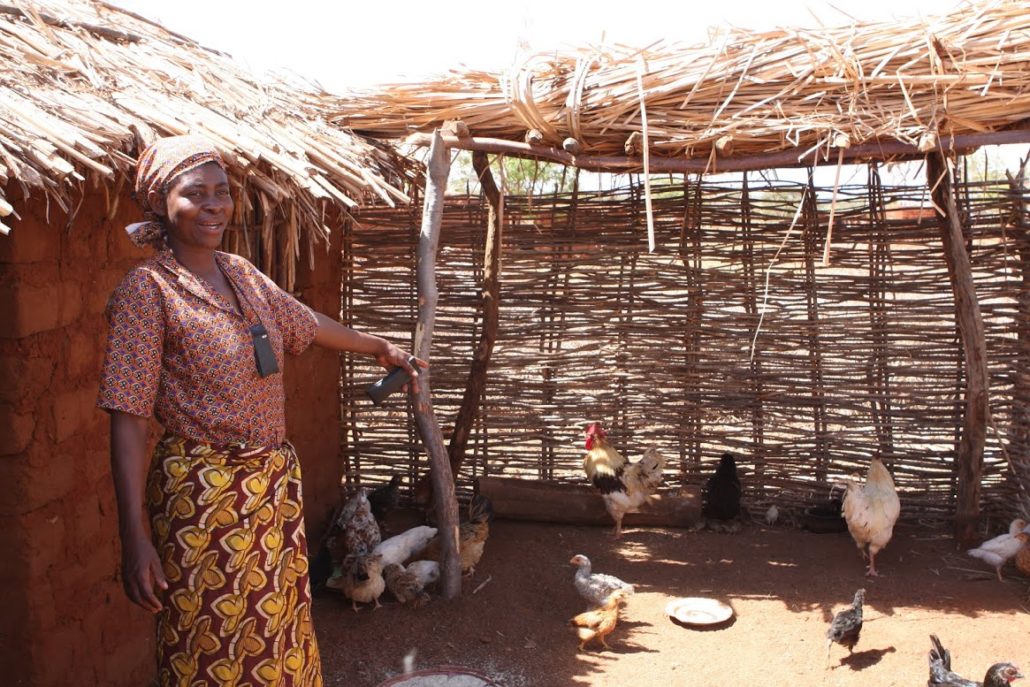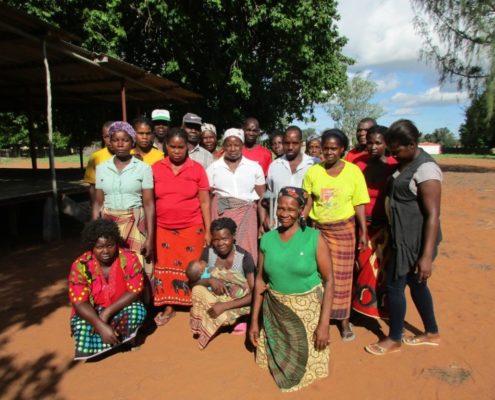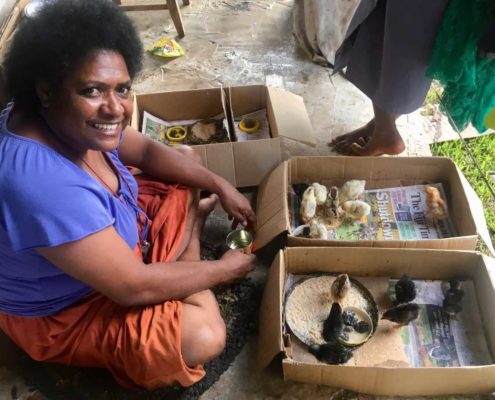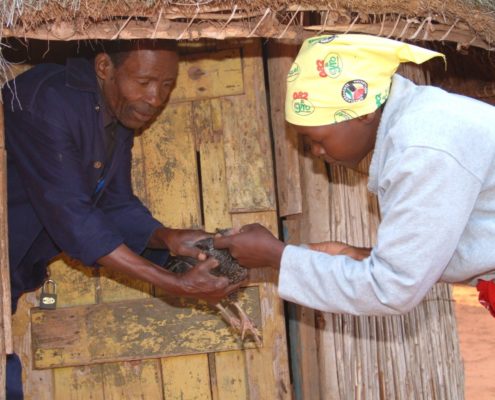Why chickens make a major contribution to women’s empowerment.
Photo credit: Ana da Felicidade Lucas (KYEEMA Field Veterinarian, Mozambique).
We have a new guest blogger at Kyeema Foundation (KYEEMA) – Juan Pablo Villanueva Cabezas. He is a PhD Scholar from the University of Melbourne’s School of Population and Global Health researching how some village chicken productive landscapes may favour the spread of Avian Influenza in Indonesian villages. Juan Pablo responds to an article published in October last year which argues that the term ‘empowerment’, particularly as it relates to development activities with women in developing countries, must be scrutinized.
We agree with Juan Pablo, that a more nuanced understanding of this word and what it actually means for the women (and their children) we work with needs to be discussed.
Recently, I came across ‘The Myth of Women’s Empowerment’ – an opinion column in The New York Times that challenged the existence of any positive effects derived from donor initiatives seeking to empower women in developing countries. The author argues these initiatives reduce non-western women to ‘mute, passive subjects awaiting rescue’ and seems to assume that donor organisations see the lack of women’s empowerment as a synonym of a lack of economic opportunities, depicting for instance initiatives involving chickens as entrepreneurship starter kits.
However, many of the projects involving chickens are not aimed at transforming women into entrepreneurs. Many of the non-western women benefited by these programmes never aspired to become full-time farmers. These women raise chickens to alleviate food insecurity, as a mean of social engagement in their communities, or to access fast cash when unexpected costs appear. Raising chickens is not the mere act of enterpreneurship, but of empowerment in specific social contexts.
Defining women’s empowerment based on chicken production is challenging and requires an appropriate understanding of the specific settings evaluated. In line with this, the recently published Women’s Empowerment in Livestock Index (WELI), the result of a collaborative effort between researchers of the International Livestock Research Institute – led by anthropologist Alessandra Galiè – and Emory University (1), may become instrumental in evaluating such empowerment. It also may help to convince sceptics that although women are not becoming big farmers, the humble chicken is making significant differences in the developing world.
Women, agriculture, and livestock
According to the World Bank (2), women are the backbone of the rural economy in developing countries. Trends show that men migrate to cities in search of work, which has encouraged more women to uptake agricultural activities. According to FAO statistics (3), about 43% of the agricultural labour force in the developing world are women, making them a principal agent of transformation and development in these regions. The United Nations Women estimates that if women farmers had the same access to credit that men have, there would be 150 million fewer hungry people (4) – a crucial step to achieving Zero Hunger by 2030 – one of the 17 sustainable development goals agreed by the United Nations in 2015 (5).
In rural areas, women are more likely to access and control livestock than land or machinery. However, this may not always warrant a better quality of life, as women make the majority of poor livestock keepers (1). In a context of increasing number of rural households being women-headed, poultry represents a democratic (everyone in the family may own them (6)), accessible, and low-investment livestock that may help to secure high-quality food and income, contributing to an increase in the household’s asset base (7).
The Women’s Empowerment in Livestock Index
WELI is inspired by and builds on previously published work Women’s Empowerment in Agriculture Index (WEAI), developed by the International Food and Policy Research Institute in 2012 (8). WELI’s development seeks to overcome limitations of WEAI in assessing women’s empowerment in areas where livestock is the dominant practice for livelihood.
WELI was developed and piloted with dairy smallholders in northern Tanzania (1) assessing women’s empowerment by quantitatively exploring six domains:
• decisions about agricultural production;
• decisions related to nutrition;
• access to control over resources;
• control and use of income;
• access to and control of opportunities; and
• workload and control over time.
Findings of the pilot study suggest that the tool is appropriate for the assessment of households where livestock is the primary agricultural activity and is especially useful for measuring women’s empowerment over time. The researchers also found that appropriate use of WELI requires the use of participatory and qualitative methods to provide context-specific insights.
A community group in the Macuacua region of Mozambique trained in improved village poultry health. Photo credit: Ana da Felicidade Lucas (KYEEMA Field Veterinarian, Mozambique).
Village chickens and women’s empowerment
Although WELI still needs further validation, it is useful to explore how local chicken production led by women in developing regions meets WELI’s six empowerment domains.
An extensive review of small-scale poultry and food security in resource-poor settings (7), found substantial evidence that women are responsible for decision-making in regards to household chicken production, even if the household is male-headed. Anecdotally, Professor Robyn Alders (University of Sydney), who has extensive work on village chicken production, has observed that increasing chicken flocks and sales of hens and roosters, allows women to buy goats of their own (9) – diversifying their livestock (and diets) and demonstrates changes in access and control of assets typically associated with men in rural settings.
The team behind WELI found that women’s decisions related to nutrition in the household are a reliable indicator of women’s empowerment. Proper control of poultry diseases, along with upskilling women in poultry farming may translate in the permanent availability of chickens and eggs, contributing to more nutritious, high quality meals. Moreover, even if women sell the chickens and eggs they produce, part of the revenue is usually invested in increasing the quantity and variety of food available in their households – once again enabling families to access better quality diets (7).
Women’s access to resources, particularly land and credit, is limited in rural settings (1) severely undermining their access to large livestock and other agricultural activities. Women can easily access the low-input nature of extensive and semi-intensive systems of village chicken production which is of vital importance because women, along with children and elders, are usually at higher risk of food insecurity (10). Chickens, therefore, represent an effective turn-around that overcomes, in part, the inequitable access of women to loans and property compared to men.
When women have complete control of their income, they invest up to 90% in their households or communities. Men, in contrast, spend less than 50% of their income in these settings (11). Providing women with chickens, husbandry and health training may empower them to profit from the activity, investing not only in food diversity, but also in greater access to health, hygiene and access to education for children – vital to breaking vicious circles of poverty and under-development.
Although most women engaged in village chicken production do so to secure household nutrition, these birds may become a profitable business opportunity for them. Local chickens are usually preferred by local consumers as these are considered ‘natural’ products of better quality in comparison to commercial breeds of poultry (12–14). The high demand for village chickens translates to high market prices and the willingness of traders to travel long distances to collect and sell these birds. The cultural value of village chickens allows for their quick commercialisation which eases the engagement of women in this business practice.
KYEEMA supports the ‘Happy Chickens’ project in Fiji run by Sustainable Environmental Livelihoods for the Future (SELF) that supports rural women to increase their income earning potential with a sustainable small business solution – selling local breed (not imported) chicks. The ultimate outcome? Increased availability of locally available meat, eggs for wider island communities in the Pacific, where poor protein nutrition availability and over-fishing of coral reef habitat is a concern in a region facing immediate effects of climate change. Photo credit: Austin Bowden Kerby (Founder, SELF).
Compared to men, women livestock keepers have less access to information and inputs, including feed or vaccines (1). Since infectious diseases pose significant threats to village chicken production, interventions to prevent them are essential. Kyeema Foundation has performed extensive work in making a vaccine against Newcastle disease – a devastating disease of village chickens in most of the developing world- available and accessible. KYEEMA has trained several women vaccinators in different countries, thus promoting gender equity in rural settings and broadening the opportunities of development associated with chickens.
KYEEMA works with a community animal health model that trains and equips both women and men to vaccinate village chickens, a sustainable side business that benefits the entire community and provides them with a broader knowledge and skillset that is respected in the community. Photo credit: Professor Robyn Alders (University of Sydney, Board Director at KYEEMA).
Quite remarkably, village chickens place little demand on women’s time as these birds excel in scavenging for their food, escaping predators, and sustaining a natural turnover of the flock, as hens can get broody in conditions where commercial breeds of chickens would not. The autonomy of these chicken systems allows women to have adequate time for other relevant context-specific responsibilities they might have (7).
In conclusion, this brief overview demonstrates that the provision of chickens along with training in farming and health makes a marked contribution towards meeting the empowerment domains proposed by WELI. Chickens, rather than ‘rescuing mute, passive non-western women’(15), are an asset that gives women an opportunity to direct their own journeys for empowerment.
If you are curious about Kyeema Foundation’s current projects in Africa and the Pacific, learn more about them here. There are subtle yet powerful outcomes for food and nutrition security driven by women, in places where alarming rates of childhood malnutrition exist.
Juan Pablo holds a Bachelor of Veterinary Medicine and Diploma of Applied Epidemiology from the Universidad de Chile and a Master in Epidemiology from the University of Melbourne. He has special interest in the links between rural and urban small-scale livestock production and public health. We look forward to future collaborations with him.
Connect with Juan Pablo on Twitter & Instagram @jpvillanuevac
References
1. Galiè A, Teufel N, Baltenweck I, Korir L, Webb Girard A, Dominguez-Salas P, et al. The Women’s Empowerment in Livestock Index. Soc Indic Res [Internet]. 2018 [cited 2018 Jul 2]; Available from: https://doi.org/10.1007/s11205-018-1934-z
2. The World Bank. Women in Agriculture: The Agents of Change for the Global Food System [Internet]. [cited 2018 Jul 12]. Available from: http://www.worldbank.org/en/news/feature/2017/03/07/women-in-agriculture-the-agents-of-change-for-the-food-system
3. Food and Agriculture Organization of the United Nations. The female face of farming [Internet]. [cited 2018 Jul 12]. Available from: http://www.fao.org/gender/resources/infographics/the-female-face-of-farming/en/
4. United Nations Women. The role of women in rural development, food production and poverty eradication 2013 | UN Women – Headquarters [Internet]. [cited 2018 Jul 12]. Available from: http://www.unwomen.org/en/news/in-focus/rural-women-food-poverty/2013
5. United Nations (UN). Sustainable development goals – United Nations [Internet]. 2015. 2015 [cited 2018 Jan 18]. Available from: http://www.un.org/sustainabledevelopment/sustainable-development-goals/
6. Bagnol B. Gender issues in small-scale family poultry production: experiences with Newcatle Disease and Highly Pathogenic Avian Influenza control. World’s Poult Sci J. 2009;65.
7. Wong JT, de Bruyn J, Bagnol B, Grieve H, Li M, Pym R, et al. Small-scale poultry and food security in resource-poor settings: A review. Global Food Security. 2016;
8. International Food Policy Research Institute. Women’s empowerment in agriculture index | IFPRI [Internet]. IFPRI. [cited 2018 Jul 19]. Available from: http://www.ifpri.org/publication/womens-empowerment-agriculture-index
9. ITALIA SivV. Newcastle diseases control – Dr. Robyn Alders [Internet]. [cited 2018 Jul 19]. Available from: https://www.youtube.com/watch?v=u1cww4PQASM
10. FAO. The State of Food Insecurity in the World 2015 [Internet]. [cited 2018 Jul 19]. Available from: http://www.fao.org/3/a-i4646e.pdf
11. OECD. DAC Guiding Principles for Aid Effectiveness, Gender Equality and Women’s Empowerment [Internet]. 2008 [cited 2018 Jul 19]. Available from: www.oecd.org/dac/gender
12. Padmawati S, Nichter M. Community response to avian flu in Central Java, Indonesia. Anthropol Med [Internet]. 2008;15(1):31–51. Available from: http://www.tandfonline.com/doi/full/10.1080/13648470801919032
13. Muladno M, Thieme O. Consumer preferences for poultry products in Indonesia. GCP/RAS/228/GER Working Paper No. 12. Rome: Food and Agriculture Organization of the United Nations; 2009.
14. Ahlers C, Alders R, Bagnol B, Cambaza AZ, Harun M, Mgomezulu R, et al. Improving village chicken production: a manual for field workers and trainers. Bruce, ACT: Australian Centre for International Agricultural Research (ACIAR); 2009.
15. Zakaria R. Opinion | The Myth of Women’s ‘Empowerment’ – The New York Times [Internet]. The New York Times. [cited 2018 Jul 12]. Available from: https://www.nytimes.com/2017/10/05/opinion/the-myth-of-womens-empowerment.html







